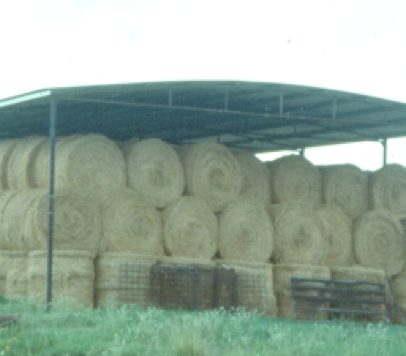
Providing nutrition when little or no pasture forage is available constitutes the single largest expense associated with most livestock operations. In most cases, hay is the most logical type of stored feed to use. Generally, the less hay required, the greater the cost effectiveness of an operation, and how hay is stored is usually what mainly determines the amount of loss. Here are a few hay storage concepts that are worthy of careful and frequent consideration.
Losses of dry hay stored inside a barn or otherwise protected from the elements are usually of little consequence. However, even for barn stored hay, losses rise sharply as moisture levels increase above 20%, and losses from round bales stored outside under adverse conditions can be much higher. During storage, hay can be subject to significant dry matter losses as well as losses of forage quality.
In the eastern United States, it is not unusual for 4 to 8 or more inches of spoilage to occur on the outside of large round bales stored outside with no protection. A weathered layer 6 inches in depth on a 5.6 foot X 5.6 foot bale contains about one-third of the package volume. Other things being equal, the percentage of hay loss decreases as bale size increases, because a smaller proportion of the bale volume is contained in the surface layer.
In areas of high and/or frequent rainfall, or with hay that does not shed water readily, the method of storage can make the difference between less than 5%, or more than 50%, dry matter loss from weathering! Furthermore, loss of more than 25% of the total digestible nutrients can occur in the most highly weathered portions of a bale. An important associated factor is that the palatability of weathered portions of bales is decreased, which lowers intake and increases refusal.
*If hay is to be stored outside, the denser or more tightly it is baled, the lower the amount of spoilage will occur, assuming hay moisture at baling is 18 to 20% or lower. Studies have shown net wrap to be more effective than twine wrap in reducing losses.
If hay must be stored outside, hay/soil contact should be prevented. When bales touch the ground there is typically much more loss that results from moisture wicking up from the soil than from rainfall from above. The flat ends of bales should be firmly butted against one another. If possible, rows should run north and south, and at least 3 feet should be left between bale rows.
Providing some type of cover to prevent penetration of rainwater is desirable, especially on loosely baled or large-stemmed hay. However, an impervious cover that extends under a bale can trap water and increase spoilage on the bottoms of bales.
Losses of hay during storage and feeding are real, and not just potential, losses. When hay losses occur, the time, thought, labor, and monetary inputs involved in producing or procuring the hay are lost along with the hay. Many people underestimate how much loss occurs from less-than-optimum storage. Anyone who is seriously interested in maximizing cost effectiveness in his or her operation needs to focus on protecting hay during storage.
__________________
Foraging Ahead is a column presented by Ragan & Massey and written by Dr. Don Ball, Professor Emeritus at Auburn University. Dr. Ball is one of the authors of the popular book “Southern Forages,” which can be found via a computer search that uses the words, “Southern Forages, The Fertilizer Institute.”
